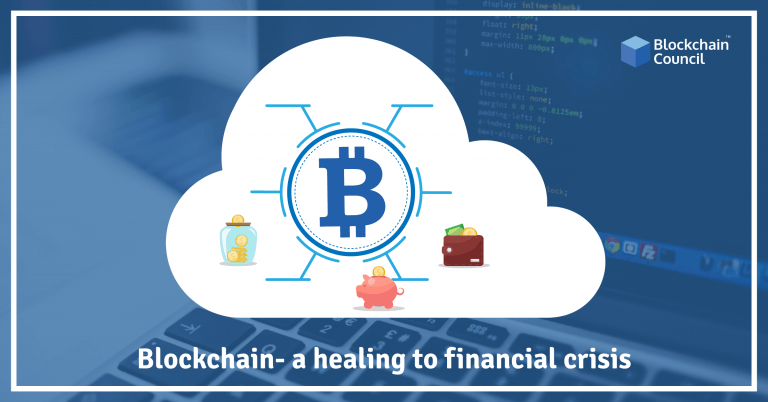
- Toshendra Kumar Sharma
- August 22, 2018
So here we are sitting in 2018, it’s been ten years when we first got to know about Blockchain. The technology came into the picture with the surge of Bitcoin in 2008. Blockchain or Distributed Ledger Technology as we all know is the underlying technology of Bitcoin or other cryptocurrencies. This is a decentralized technology which emphasizes on peer-to-peer transactions nullifying the need of the third party.
It won’t be wrong to claim that blockchain is looked upon as the technology of the future for various reasons, the first and the most important is decentralization. Since blockchain completely culminates the need for having a third party, it becomes an excellent platform for financial transactions which otherwise consumes a lot of time in validation, approval, and processing. Moreover, there are minimal processing fees which are not the case with the current mode of financial transactions.
How can Blockchain heal the Financial Crisis?
Well, to understand how blockchain can be helpful in healing or preventing the financial crisis we first need to analyze the key features of this technology which can prove to be helpful for the banks and other financial institutions. In 2008 the world witnessed the biggest bankruptcies of all time. Lehman Sachs declared bankruptcy, and it spread like wildfire across the globe. Most of the nation’s economy was disrupted leaving to the high rate of attrition and closure of companies. So, can blockchain help in preventing this? This is the biggest question that the companies might be eyeing at the moment.
Let’s admit the fact that one of the primary reason for bankruptcy is lack of transparency. Since blockchain offers transparency and easy traceability, many banking, financial and auditing companies are looking forward to this technology. We all know that the financial crisis of 2008 had a huge impact on the economy of the world and one of the primary reason for this was lack of transparency. Blockchain can prove to be beneficial in this aspect. Since this platform is highly transparent, it can help the authorities to trace the cash flow easily and also find out areas of discrepancies to avoid any problems.
What are the key features of Blockchain that can prove to be beneficial for financial institutions?
Before heading further, let’s understand the key areas on which the financial institutions and blockchain experts should start working to avoid repetition of the financial crisis of 2008 :
- Decentralization– This is the key aspect of blockchain and can prove to be beneficial for the people to skip the approval period of banking and financial institutions and transact directly.
- Transparency– We know that blockchain is a transparent system which allows the people in the network to easily view the entries in this ledger thus making tracking and tracing easy.
- Time Stamping– The information in the DLT or Distributed Ledger Technology is present in chronological Thus, any change or alteration can be easily deciphered.
Let’s understand how these features can be explored on the ground level:
- Ensuring financial security– So this is the first area of interest for everyone, from an ordinary man to the banking authorities. If the authorities have a clear picture of the cash flow and they know what is happening in the system, they can easily gauge any discrepancies if there are any. Tracking of cash flow ensures that the authorities know if there are any faulty policies or operations functioning I the system and thus they can work upon it.The authorities can also get to know if there is a need for a monetary policy that can improve the efficiency of the system. They will also get an insight into whether they should increase or decrease the lending rate.
- Prevention of fraud to avoid financial crisis- One of the most talked about feature of blockchain is cryptography. All the information present on blockchain is stored using cryptography. If someone wants to access this information they must have the key for the same. The fact of the matter is that the key is with the owner of the information. Even then, if the hacker tries to breach the system, then the person has to violate the entire system connected on the network since the data is distributed to the nodes. Thus, reducing the probability of hacking or alteration of information.
- Smart Contracts– This is yet another key aspect of the These are an electronic agreement between two parties which automatically executes when the pre-defined conditions are met. In the case of banking and financial institutions, they can use it to file a deal or agreement between the parties. Thus it reduces the need to gauge the entire process every time. Once the set conditions are met the payment will be released directly to the parties.
Secondly, the digital identities can be used to avoid loan frauds. The banking and financial institutions can introduce the digital identities to check if the customers are trustworthy. Moreover, with the information of the customer present on the ledger, the banks, and financial institutions can directly see the track record of the customer and based on it they can grant the loan.
Thus, we see that the blockchain offers myriads of options to make the banking and financial system foolproof and thus avoiding the surge of the financial crisis that has happened previously. However, an important point to note here is that these processes are still at a nascent stage and we need to work on Blockchain to improvise the areas of improvement.





































































 Guides
Guides News
News Blockchain
Blockchain Cryptocurrency
& Digital Assets
Cryptocurrency
& Digital Assets Web3
Web3 Metaverse & NFTs
Metaverse & NFTs
